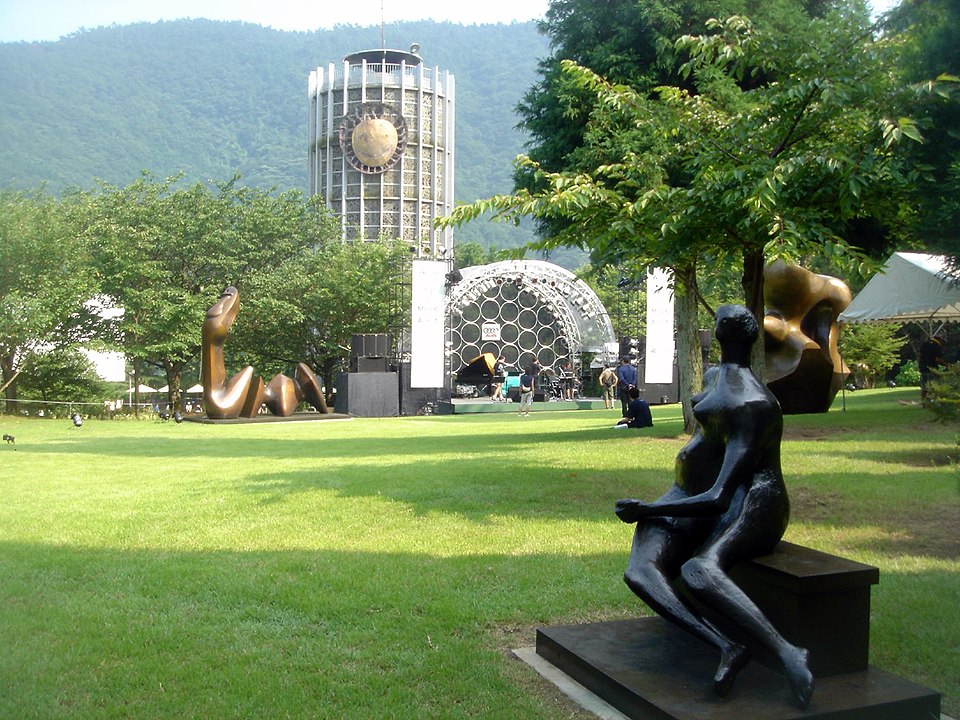The Hakone Open Air Museum is a unique art paradise that perfectly blends sculptural art with natural beauty. Showcasing works by numerous international artists while offering spectacular views of the valley and mountains, it provides visitors with a visual feast and artistic inspiration.
Key Information
- Location: Hakone, Kanagawa Prefecture
- Established: 1969
- Area: Approximately 70,000 square meters
- Artworks: Over 120 outdoor sculptures and multiple indoor exhibition halls
- Main Highlights: Picasso Pavilion, Symphonic Sculpture, Children’s Play Areas
Historical Background
The Hakone Open Air Museum opened in 1969 as Japan’s first outdoor museum. The founder’s vision was to create a space where art and nature coexist harmoniously, allowing visitors to appreciate art while immersed in natural beauty. For over half a century, the museum has continually expanded its collection, becoming one of the world’s most renowned open-air museums.
Main Attractions
Picasso Pavilion
The Picasso Pavilion is one of the museum’s core highlights. This two-story exhibition hall is dedicated to Picasso’s works, including paintings, sculptures, and ceramics. The pavilion not only showcases Picasso’s artistic creations but also presents his life through a series of photographs. Visitors can closely appreciate Picasso’s representative works, experiencing his unique artistic style and creative concepts. The layout is carefully designed to allow viewers to understand the development of Picasso’s artistic career chronologically, gaining deep insight into his enormous contribution to modern art.
Outdoor Sculpture Park
The museum’s outdoor area is a vast green space dotted with abstract sculptures from Japanese and international artists. These sculptural works create a unique visual experience in harmonious contrast with the surrounding natural environment. Visitors can stroll on the lawn, appreciating these large-scale sculptures up close and feeling the perfect fusion of art and nature. Each sculpture is carefully arranged, considering its interaction with the surroundings and the effects under different seasons and lighting, providing visitors with a changing artistic experience throughout the year.
Symphonic Sculpture
The Symphonic Sculpture is one of the most striking works in the museum. This towering tower-like sculpture is not only an artwork but also an interactive installation that can be climbed. Visitors can enter the sculpture and ascend the spiral staircase. The staircase is flanked by vibrant stained glass, presenting different color effects as the sunlight changes. Upon reaching the viewing platform at the top, visitors can enjoy magnificent views of the entire park and surrounding mountains. This piece perfectly embodies the museum’s concept of combining art, architecture, and natural landscapes.
Indoor Exhibition Halls
In addition to the outdoor exhibition area, the museum has several indoor exhibition halls hosting regular themed exhibitions. These halls display works by different artists and schools, covering various forms such as paintings, sculptures, and installations. The design of the indoor exhibition halls considers the use of natural light, bringing outdoor scenery into the interior through large floor-to-ceiling windows, creating a unique viewing experience. Regularly changing exhibitions provide freshness for regular visitors and attract more art enthusiasts to visit multiple times.
Children’s Play Areas
The museum pays special attention to children’s art education, setting up multiple play spaces for kids. The most popular among these is “Zig Zag World,” a soft art installation where children can play freely, cultivating their interest in art. These interactive areas not only allow children to enjoy the fun of art but also provide more options for family outings.
Outdoor Foot Bath
The museum also offers an outdoor foot bath area, allowing visitors to relax body and mind while appreciating art. The foot bath area utilizes Hakone’s rich hot spring resources, with comfortably warm water. Visitors can soak their feet while enjoying the surrounding sculptures and natural scenery, making it an ideal place to relax after the visit.
Best Time to Visit
The Hakone Open Air Museum is open year-round, with each season offering its unique charm:
- Spring (March-May): Cherry blossoms in full bloom, creating a beautiful contrast with the sculptures
- Summer (June-August): Lush greenery, the best season for appreciating outdoor sculptures
- Autumn (September-November): Fall foliage season, with colorful and vibrant scenery
- Winter (December-February): Possible snow scenes, sculptures covered in white for a different flavor
It’s advisable to avoid Japanese holidays like Golden Week and New Year to prevent overcrowding that might affect the viewing experience.
Transportation Guide
From Tokyo:
- Take the Shinkansen or Odakyu Line to Odawara Station
- Transfer to the Hakone Tozan Railway at Odawara Station to Chokoku-no-Mori Station
- Walk about 2 minutes from Chokoku-no-Mori Station to reach the museum
From Hakone-Yumoto:
- Take the Hakone Tozan Railway to Chokoku-no-Mori Station (about 30 minutes, 460 yen)
- Walk about 2 minutes from the station
Note: The Hakone Free Pass covers transportation costs in the Hakone area, recommended for saving expenses.
Opening Hours and Ticket Information
Opening Hours:
- Daily from 9:00 AM to 5:00 PM (last entry at 4:30 PM)
- Open year-round
Admission:
- Adults: 2,000 yen
- With Hakone Free Pass: 1,900 yen
- Online booking: 1,800 yen
Visitor Tips and Advice
- Allow at least 3-4 hours for the visit to fully appreciate all exhibits
- Wear comfortable shoes as there’s a lot of walking involved
- Bring sun protection and rain gear to cope with changeable weather
- Consider purchasing an audio guide for in-depth information about the artworks
- Don’t miss the museum’s souvenir shop, which offers many unique art-related items
- Take a break at the museum’s café, enjoying food while appreciating the scenery
Official Website
Conclusion
The Hakone Open Air Museum is a unique art paradise that perfectly combines world-class sculptures and paintings with Hakone’s charming natural scenery. Whether you’re an art enthusiast, nature lover, or traveler seeking inspiration, this place offers an unforgettable experience. Here, you can appreciate art while immersed in the beauty of nature, feeling the harmonious coexistence of art and nature. Make the Hakone Open Air Museum a must-visit destination on your journey to explore Japanese art and culture!
